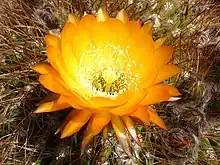Soehrensia formosa
Soehrensia formosa, is a species of Echinopsis found in South America. In north-western Argentina, Bolivia and northern Chile.[2] First published in Cactac.: Handb. Kakteenk. 3: 1678 in 1959.[2]
| Soehrensia formosa | |
|---|---|
 | |
| Scientific classification | |
| Kingdom: | Plantae |
| Clade: | Tracheophytes |
| Clade: | Angiosperms |
| Clade: | Eudicots |
| Order: | Caryophyllales |
| Family: | Cactaceae |
| Subfamily: | Cactoideae |
| Genus: | Soehrensia |
| Species: | S. formosa |
| Binomial name | |
| Soehrensia formosa (Pfeiff.) Jacobi ex Salm-Dyck 1849 | |
| Synonyms | |
| |
Description
Soehrensia formosa grows singly at first, later occasionally branching out from the base and then forming groups. The spherical to cylindrical, light green to blue-green shoots reach heights of growth of up to 1.5 meters with a diameter of 25 to 50 centimeters. There are 27 to 50 rounded ribs that are clearly notched and tuberous. The dark areoles located on them are up to 1 centimeter apart. Needle-like, yellowish to reddish-brown thorns emerge from them. The two to nine central spines are 3 to 20 centimeters long. The nine to 15 radial spines are spread out, straight or slightly curved and have a length of up to 3 centimeters.
The broad, funnel-shaped, red to orange-red to yellow flowers appear near the top of the shoot and are open during the day. They are 6 to 9 centimeters long and have the same diameter. The broad, spherical, green fruits are up to 3 centimeters long and 4 centimeters in diameter.[3]
Subspecies
Has 5 Accepted subspecies;[2]
- Soehrensia formosa subsp. formosa
- Soehrensia formosa subsp. kieslingii (Rausch) Schlumpb.
- Soehrensia formosa subsp. korethroides (Werderm.) Schlumpb.
- Soehrensia formosa subsp. randallii (Cárdenas) Schlumpb.
- Soehrensia formosa subsp. rosarioana (Rausch) Schlumpb.
Distribution
Soehrensia formosa is widespread in the Bolivian department of Tarija, in the Argentine provinces of Salta, Tucumán, Catamarca, La Rioja, San Juan and Mendoza as well as in the adjacent northeast of Chile in the high altitudes of the Andes of up to over 4000 meters.
Taxonomy
The first description as Echinocactus formosus by Ludwig Georg Karl Pfeiffe was published in 1837.[4] The specific epithet formosa is derived from the Latin word formosus for 'stately' and refers to the appearance of the plants. Boris O. Schlumpberger placed the species in the genus Soehrensia in 2012.[5] Further nomenclature synonyms are Echinopsis formosa (Pfeiff.) Jacobi ex Salm-Dyck (1850), Acanthocalycium formosum (Pfeiff.) Backeb. (1936), Lobivia formosa (Pfeiff.) Dodds (1937) and Trichocereus formosus (Pfeiff.) F.Ritter (1980). Was once thought to be a species of Echinopsis.
References
- Faundez, Luis (2010-09-22). "The IUCN Red List of Threatened Species". IUCN Red List of Threatened Species. Retrieved 2023-08-27.
- "Soehrensia formosa (Pfeiff.) Backeb. | Plants of the World Online | Kew Science". Plants of the World Online. Retrieved 29 October 2022.
- Anderson, Edward F.; Eggli, Urs (2005). Das grosse Kakteen-Lexikon (in German). Stuttgart (Hohenheim): Ulmer. p. 229–230. ISBN 3-8001-4573-1.
- Pfeiffer, Ludwig Georg Karl (1837). Enumeratio diagnostica cactearum hucusque cognitarum /auctore Ludovico Pfeiffer. Berolini: L. Oehmigke. doi:10.5962/bhl.title.15207.
- Korotkova, Nadja; Aquino, David; Arias, Salvador; Eggli, Urs; Franck, Alan; Gómez-Hinostrosa, Carlos; Guerrero, Pablo C.; Hernández, Héctor M.; Kohlbecker, Andreas; Köhler, Matias; Luther, Katja; Majure, Lucas C.; Müller, Andreas; Metzing, Detlev; Nyffeler, Reto; Sánchez, Daniel; Schlumpberger, Boris; Berendsohn, Walter G. (2021-08-31). "Cactaceae at Caryophyllales.org – a dynamic online species-level taxonomic backbone for the family". Willdenowia. Botanic Garden and Botanical Museum Berlin, Freie Universitaet Berlin. 51 (2). doi:10.3372/wi.51.51208. ISSN 0511-9618.
External links
 Media related to Soehrensia formosa at Wikimedia Commons
Media related to Soehrensia formosa at Wikimedia Commons Data related to Soehrensia formosa at Wikispecies
Data related to Soehrensia formosa at Wikispecies
